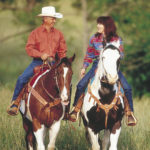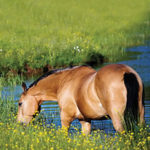It is no surprise to riders that one of the greatest causes of emergency room visits across the country is related to equestrian activities. Horses are volatile and unpredictable at times, and accidents can happen in a heartbeat. By following some basic guidelines, many bad incidents may be avoided.

Always check your horse’s cinch or girth before and after mounting, and again after riding a short distance. Make sure all tack is in good working order.
Head injuries comprise about 15-20% of riding accidents. Whenever mounted, wear an ATSM-certified helmet, and don’t wear anyone else’s helmet. You should have a helmet fitted specifically to your head. If your helmet has sustained a blow or impact, discard it and replace it.
Appropriate footgear is important. Your boots should have a small heel to protect your foot from slipping through a stirrup. And, when trail riding, it is best to wear shoes that can double as hiking boots in instances where you might need to lead your horse across difficult terrain.
Gloves are helpful to protect fingers and hands from abrasions and for those instances when you need to remove debris or cactus from your horse’s legs. Wear long-sleeved shirts to protect you from scrapes caused by brushing through tree branches and riding near rocky outcroppings, and also to shield from sunburn. Make sure you have rain gear and an article of warm clothing in your saddle pack. Monitor the weather in advance of your trail ride so you know what to expect.
Bring ample water along to prevent dehydration and carry an energy bar or snacks for hunger pangs.It’s smart to stock waterproof matches, a pocketknife or all-purpose tool, and a flashlight just in case you get stuck out longer than expected.
Keep a simple first aid kit on your saddle; many of the supplies you’d use on horses also have human application. Talk to your veterinarian about appropriate supplies to carry with you.
Important emergency supplies, and particularly your cell phone, are best kept on your person in case you and your horse part ways. Make sure your cell phone is adequately charged. Carry current maps with you of the area you’ll be exploring. Advise friends or loved ones of your intended trail course, particularly if you are riding alone. Do not deviate from your scheduled route no matter how interesting another path might appear. Learn how to use a GPS and have one with you. A cell phone GPS app is handy provided you have mobile service where you’ll be riding.
Slow down on tricky terrain. Recognize situations where your horse might be over-faced for his abilities and experience. Don’t push him into an uncomfortable situation; instead find an alternative option. Stay on trail if possible; if you must deviate briefly, get back on an established trail as quickly as possible.
No matter where you go or for how long a trail ride, it is always best to ride with a friend for practical and safety reasons. Use good common sense, pay attention to your horse and come home safe and sound.





